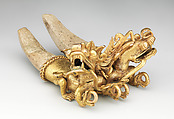Double Crocodile Pendant
Not on view
This double-animal pendant was created by a particularly skilled master metalsmith and displays astonishingly elaborate anatomical detail. Head crests, long split tongues, eyes on stalks, looped-up noses, and open fanged mouths give the creatures a lively air. The smooth chalky surface of the tails of shell contrasts well with the grainy texture of the gold bodies. Although commonly called crocodiles, these creatures possess features characteristic of bats, such as the eyes, nose, and ears. Some researchers have suggested that these figures may be depictions of lizards or iguanas, animals closely associated with rulership and power.
Similar objects have been excavated from elaborate burials at the archaeological sites of El Caño and Sitio Conte in the Coclé Province of Panama. Deceased chiefs were covered in fine gold ornaments, including decorated plaques, pendants, ear rods, embossed cuffs for wrists and ankles, and many strands of gold beads. Some of these gold ornaments included other precious materials, including greenstone, emerald, and sperm whale tooth. As many as twenty-five individuals would have accompanied the principal occupant of the tomb into the afterlife.
Goldworking technologies—including hammering, alloying, annealing, gilding, and casting—are believed to have come to Central America from the Andean region of South America around AD 700. The majority of works from the area of the Isthmus of Panama were cast, and the most frequent form was the effigy pendant. These were produced in various animal and human forms, or combinations thereof, and were worn suspended from the neck by a thong or cord. In this example, the cord would have been strung through small gold loops located under the creatures’ front feet, so when worn they would be facing up in the direction of the wearer’s head.
Further Reading
Cooke, Richard G., et al., eds., To Capture the Sun: Gold of Ancient Panama (Tulsa, OK: Gilcrease Museum, 2011).
Jones, Julie. The Art of Precolumbian Gold: The Jan Mitchell Collection (New York: The Metropolitan Museum of Art, 1985).
Mayo, Julia and Juan Carles, eds., Guerreros de oro: Los señores de Río Grande en Panamá = Golden Warriors: The Lords of Río Grande in Panama (Panamá: Editora del Caribe, Fundación El Caño, 2015).
Pillsbury, Joanne, Timothy Potts, and Kim N. Richter, eds., Golden Kingdoms: Luxury Arts in the Ancient Americas (Los Angeles: The J. Paul Getty Museum, 2017).
Quilter, Jeffrey, and John W. Hoopes, eds., Gold and Power in Ancient Costa Rica, Panama and Colombia: A Symposium at Dumbarton Oaks, 9 and 10 October 1999 (Washington, D.C.: Dumbarton Oaks Research Library and Collections, 2003).
Due to rights restrictions, this image cannot be enlarged, viewed at full screen, or downloaded.


